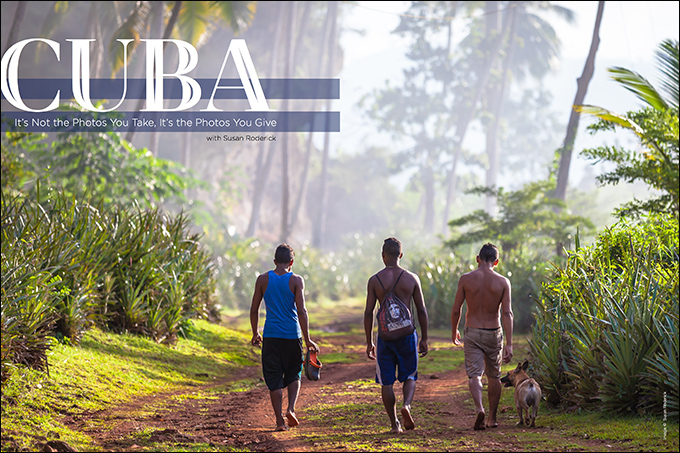Cuba: It’s Not the Photos You Take, It’s the Photos You Give with Susan Roderick
Traveling to Cuba has been on my bucket list for years. Many of us in the United States hope to walk the streets of Havana before McDonald’s appears on every street corner. Luckily, I got a chance last December and would like to share a few basic travel tips I picked up on my journey. More importantly, I want to share with you the meaningful exchange I had with the people living on this island, seemingly frozen in time.
First, let’s cover a few of the things you need to know if you want to travel to Cuba from the United States in 2016. Although the country is still not officially open to American tourists, it’s fairly easy to go. There are 12 visas you can apply for. When I say “apply,” I mean you choose without needing approval from a government agency. I went with a “People to People” visa, which was issued by the airline charter company. Airline charters are still the only way for Americans to legally get there. (I used ABC Charters.) I would like to emphasize the fact that tourism from the United States is not allowed. If you’re looking for an easy beachy getaway, you may want to look elsewhere.
Although Cuba is in the midst of an exciting period of change, the chances of a cruise ship landing in Havana carrying 3,000 Americans is still far off. The country does not appear to have the infrastructure for that number of people to arrive in a single day. The restaurants would be overwhelmed and people would be waiting hours to eat, especially at the slow-paced government restaurants—which, a local warned me, should be avoided at all costs due to poor health standards. You can always tell government restaurants from privately owned restaurants because they sit mostly empty. A good policy is to eat at restaurants that are full of customers.
The big hotels have Wi-Fi, but you should plan to spend much less time on the Internet then you are accustomed to doing at home. Also, unless you opt for an expensive per-minute phone plan, you won’t be able to use your phone while you are there. Recently, the Cuban people have been able to access hot spots in major cities. If you see dozens of people standing on a street corner looking down at their devices, you have found one. You need to ask around for a Wi-Fi access card, which only a few businesses sell. I was told that the Cuban government does not censor the Internet, so the people are free to explore the World Wide Web in all its glory. This may be the single most important contribution to the rapid cultural changes taking place.
One way to get to know the Cuban people is to stay in their homes. Home stays, or casa particulares, cost $25 to $30 a night per person. If you are a good negotiator, breakfast may also be included. Staying in a family home is one of the best ways to have a more authentic experience, especially when you stay for dinner. You will have to pay for the extra meal, but it will be well worth it. Homeowners are often very helpful in suggesting other casa particulares if you are traveling to more than one city. Keep in mind that you won’t be able to use credit cards, so bring enough cash for your entire trip.
As photographers, we go to exotic locations with big plans of adding epic images to our portfolio. In Cuba, there is no shortage of breathtaking landscapes, smiling children and classic American cars driving past colorful art-deco buildings. You will most likely get the shots you have dreamed of adding to your collection. But I learned something very important on this trip. Taking an incredible image for yourself is not the most rewarding thing you can do; the most meaningful part of my journey was giving the Cuban people photos of themselves.
Before my trip, several people explained to me that Cubans have been in desperate need of everyday items for decades. I was told to bring an extra suitcase filled with clothes, lotions, pens, makeup, toys and electronics. I did exactly that, and doled these items out to locals as I traveled from town to town. However graciously (or, in some cases, ungraciously) the people accepted the gifts, it felt incredibly presumptuous to hand total strangers what I thought they needed. Remember that tourists from all over the world, except the United States, have been handing out pens to children there for over 50 years. There are more meaningful ways to give something to the Cuban people.
Taking an instant camera on a trip is not a new concept, but bringing this novelty item to a closed country like Cuba can make magic happen. The people have little means or even access to printing photos of themselves or their loved ones. It’s as simple as approaching someone and asking if you can take a photo of them, for them. “¿Puedo tomar una foto de usted para usted?” This is the best icebreaker if you have difficulty approaching people for photographs. Once you hand them an instant image, they are usually more than happy to pose for a portrait for you to keep. I will never again travel anywhere without my Fuji Instax instant camera. This small gift touched more hearts more deeply than all of the other gifts I brought put together.
This lesson was brought home as I sauntered down the street of Baracoa, a town on the eastern tip of the island. I like to strike up conversations with people sitting outside on their stoops. So I stopped to talk with a woman and her mother for a while, and ended up taking a few instant photos of them individually and together. They were absolutely thrilled, and said it was the first photo they had of the two of them. A short time later, the woman’s husband pulled up in a horse cart to collect some wood. She handed her husband one of the photos, and he immediately began to cry. A grown man crying at the sight of a photo of his wife made us all start crying! First the woman’s, then the mother’s and then my own tears started to fall. I was in total disbelief at this reaction to something I do every day. It was the most beautiful moment I had in Cuba.
This is the pinnacle of creating a human connection with your camera. We all understand the importance of a photograph. An image of your husband or your child may be your most valuable possession. Give people this priceless gift if you get the opportunity to visit this fascinating country.
Instead of packing that third or fourth lens, pack some extra film for your instant camera. You gain so much more from giving the perfect photo than you do by taking it.




